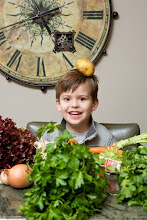
You've got to feel sorry for the celery root. The lumpy, grey green vegetable is continually overshadowed by its shallow and flamboyant plume (celery has got to be the vegetable's equivalent to the dumb blonde). Even in these days of scarcity, the celery root isn't much to look at. It suffers in comparison to the other roots of winter, the showy beet, golden rutabaga, and red-headed carrot - even the lowly turnip has a rosy blush to its cheeks, like a sturdy farm girl. Only burdock, edges it out in ugliness. And while usually, the French moniker makes a food more palatable (think escargot v. snail), but in this case, celeriac makes me think of celiac's disease - ugh.
It's a shame, because the celery root requires little effort to shine. In fact, it's one of the few underground dwelling vegetables that you don't need to cook prior to eating. It can be mashed, frittered, gratined, and, as in the following, recipe, grated and dressed.
I served this dish, Celery Root Remoulade, at a recent party. It was one of the most popular dishes, I supect in large part, because its unfamiliarity led to a false sense of exoticness. The swan emerged.
With a food processor, this recipe can be made in just a few minutes making it a great weeknight side dish.
Celery Root Remoulade
6 to 8 servings
1 celery root
1/2 lemon
1 cup mayonnaise, either homemade or Hellman's
1 teaspoon whole grain mustard
2 tablespoons capers, drained
2 tablespoons chopped Italian parsley
1/2 teaspoon kosher salt
Peel and julienne the celery root - this is easily done in a food processor. Mix the celery root and lemon juice in a large bowl. Mix in the remaining ingredients.
Mayonnaise
Makes approximately 2 cups
2 egg yolks
1 teaspoon Dijon mustard
1 tablespoon lemon juice
1 1/2 cup canola oil
Kosher salt and freshly ground pepper
Food Processor Method: Combine the egg yolks and mustard in the bowl of a food processor. Through the feed tube, pour the oils in a very slow stream while the machine is on. The aioli is done when it’s thick and emulsified. When fully emulsified, the mixture will make a distinctive slapping sound against the sides of the bowl. Mix in the lemon juice and season with salt and freshly ground pepper to taste.
By Hand: Combine the egg yolks and mustard in a medium size bowl. Wrap a kitchen towel around the base of the bowl to anchor it. Pour the oils into the egg mixture in a slow stream until the two are emulsified. Mix in the lemon juice and season with salt and freshly ground pepper to taste.
Fixing a broken mayonnaise: It is almost certain that if you make mayonnaise or aioli more than once, it will break. There’s no need to start over. Simply whisk 1 teaspoon of Dijon mustard in a mixing bowl, add 1 tablespoon of the broken mayonnaise (make sure that you stir it up first to ensure that you get oil and egg in the sample), whisk together until the mixture thickens. Slowly add the remaining broken mayonnaise, whisking constantly until emulsified.
Doctoring store bought mayonnaise: If you’re concerned about using raw eggs or are pressed for time, you can easily doctor a commercially produced mayonnaise. Take 2 cups of store bought mayonnaise (I suggest Hellman’s) and add the lemon juice and Dijon mustard called for in this recipe. Add salt and freshly ground pepper to taste.
































